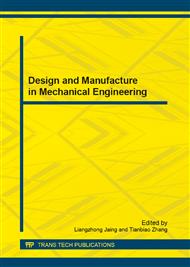[1]
M. Rosenblum and B. Gothard: A high Fidelity Multi-Sensor Scene Understanding System For Autonomous Navigation, Proceedings of the IEEE Intelligent Vehicles Symposium 2000 Cat No00TH8511 (2000), no. Mi, p.637–643.
DOI: 10.1109/ivs.2000.898420
Google Scholar
[2]
J. Palacin and J. Salse: Building a mobile robot for a floor-cleaning operation in domestic environments, Proceedings of the 20th IEEE Instrumentation Technology Conference Cat No03CH37412 (2003), vol. 53 (2004), no. 5, p.1418–1424.
DOI: 10.1109/imtc.2003.1207979
Google Scholar
[3]
G.R. Pipes, U.S. Patent 4, 657, 463. (1986).
Google Scholar
[4]
R. A. Russell, D. Thiel, R. Deveza, and A. Mackay-Sim: A robotic system to locate hazardous chemical leaks, Proceedings of 1995 IEEE International Conference on Robotics and Automation, vol. 1 (1995), p.556–561.
DOI: 10.1109/robot.1995.525342
Google Scholar
[5]
Z. Li, J. Zhu, C. He, and W. Wang: A new pipe cleaning and inspection robot with active pipe-diameter adaptability based on ATmega64, 2009 9th International Conference on Electronic Measurement & Instruments, (2009), p.2–616–2–619.
DOI: 10.1109/icemi.2009.5274509
Google Scholar
[6]
J. P. Ruurda, T. J. M. V van Vroonhoven, and I. a M. J. Broeders: Robot-assisted surgical systems: a new era in laparoscopic surgery, Annals of the Royal College of Surgeons of England, vol. 84 (2002), no. 4, p.223–6.
DOI: 10.1308/003588402320439621
Google Scholar
[7]
S. Sukkarieh: A high integrity IMU/GPS navigation loop for autonomous land vehicle applications, IEEE Transactions on Robotics and Automation, vol. 15 (1999), no. 3, p.572–578.
DOI: 10.1109/70.768189
Google Scholar
[8]
V. Kulyukin, C. Gharpure, J. Nicholson, and S. Pavithran: RFID in robot-assisted indoor navigation for the visually impaired, 2004 IEEE/RSJ International Conference on Intelligent Robots and Systems (IROS) (IEEE Cat. No. 04CH37566), vol. 2 (2004).
DOI: 10.1109/iros.2004.1389688
Google Scholar
[9]
M. Ocaña and L. Bergasa: Indoor robot navigation using a POMDP based on WiFi and ultrasound observations, in 2005 IEEERSJ International Conference on Intelligent Robots and Systems, (2005), p.2592–2597.
DOI: 10.1109/iros.2005.1545031
Google Scholar
[10]
Y. Sung-II Jung, U.S. Patent 6, 493, 614. (2002).
Google Scholar


